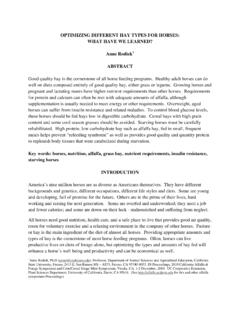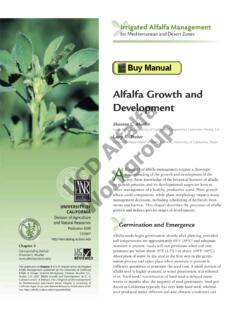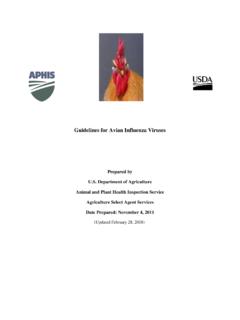Transcription of January 2011 Questions and Answers: Roundup …
1 APHIS FactsheetBiotechnology Regulatory Services January 2011 Questions and answers : Roundup ReadyAlfalfa DeregulationThe Department of Agriculture (USDA) is making available two decisionmaking documents related to the regulation of alfalfa that has been genetically engineered to be resistant to the herbicide commercially known as Roundup . The ! rst is a determination of nonregulated status for Roundup ready alfalfa . This determination, based on a thorough plant pest risk assessment prepared by USDA s Animal and Plant Health Inspection Service (APHIS), ! nds there is no plant pest risk associated with Roundup ready (RR) alfalfa . Consistent with the plant pest provisions of the Plant Protection Act and APHIS regulations, the agency has reviewed the necessary and relevant scienti! c data and has found that Roundup ready alfalfa exhibits no plant pest properties.
2 Therefore, APHIS is granting the petition to deregulate Roundup ready alfalfa , which will become effective upon publication of the determination in the Federal Register. The second document is a Record of Decision, which selects the second alternative evaluated as part of the ! nal Environmental Impact Statement (EIS), for the petition to grant nonregulated status for RR alfalfa . Based on its plant pest risk assessment, the analysis in the EIS, and public comments on both the draft and ! nal EIS, APHIS is selecting Alternative 2-- deregulation in full of Roundup ready alfalfa . The Record of Decision is available for viewing online at Why did APHIS choose alternative 2, to deregulate RR alfalfa ?A. APHIS chose alternative 2 because RR alfalfa did not present a greater plant pest risk than other conventional alfalfa varieties.
3 In fact, APHIS did not ! nd any direct or indirect plant pest risks associated with RR alfalfa . APHIS concluded the following in its plant pest risk assessment: RR alfalfa exhibited no plant pathogenic properties although a plant pathogen was used in their development, these plants are not infected by this organism nor do they contain genetic material from pathogens used as a donor organism that can cause plant disease. APHIS believes Alternative 2 best meets the overall purpose and need for agency action identi! ed in the ! nal Why didn t APHIS choose alternative 3, as previously co-preferred in the ! nal EIS?A. APHIS decided not to choose alternative 3 because RR alfalfa did not exhibit a greater plant pest risk in the geographically restricted areas described in alternative 3. Therefore it would not be consistent with APHIS regulatory authorities.
4 Q. What does this decision mean for farmers?A. With this decision, farmers can freely move and plant RR alfalfa seed without further oversight from APHIS. Although APHIS would no longer have any regulatory control over the planting, distribution, or other actions related to RR alfalfa , APHIS does assume that growers would continue to be subject to contract restrictions imposed by Monsanto s technology use agreement. These nonregulatory restrictions include managing hay to prevent seed production, harvesting at or before 10 percent bloom in areas where seed is produced, and prohibitions on use in wildlife feed plots. Similarly, growers who raise alfalfa for seed are assumed to be directly contracted by the licensee, Forage Genetics, and are required to follow Forage Genetics Best What impacts would RR alfalfa have on other plant and animal species?
5 A. RR alfalfa is not expected to adversely affect plants and animals, including threatened and endangered species. RR alfalfa is not expected to become more invasive in natural environments or have any different effect on critical habitat than traditional alfalfa . In addition, the nutritional pro! les of RR alfalfa and traditional alfalfa are not different (within normal cultivar variations); therefore animal nutrition is not expected to be different. Q. Does RR alfalfa have adverse effects on humans?A. RR alfalfa has no adverse effects on human health and worker safety. Overall risk of glyphosate and other herbicide use to human health and worker safety does not change with the adoption of RR alfalfa . Environmental Protection Agency has determined that the use in accordance with the labeling of currently registered pesticide products containing glyphosate has a reasonable certainty of no harm to humans and no unreasonable adverse effects to the environment, including its use on What was the outcome of the coexistence discussion USDA began in December?
6 A. In December 2010, USDA asked a diverse group of stakeholders who care about alfalfa production to come together to start an important dialogue regarding ways in which they and USDA can work together to help ensure that GE, organic and other non-GE sectors can continue to thrive and be successful. These stakeholders helped to identify areas of consensus; issues where the group disagreed and believed additional study and discussion would bene! t; and areas where USDA could or should play an important and helpful How will USDA be supporting the coexistence efforts these stakeholder groups have identi! ed?A. USDA s goals will be to help maintain purity of non-GE alfalfa seed, from germplasm to commercial use; improve stewardship practices and develop new tools to lessen the risk of gene " ow in alfalfa ; and assist in strengthening cooperation and coexistence among alfalfa producers.
7 Some of the speci! c steps USDA will take to achieve these goals include: Reestablishing two important USDA advisory committees Advisory Committee on biotechnology and 21st Century Agriculture, and the National Genetic Resources Advisory Committee. These two committees will tackle a broad range of issues, from ensuring the availability of high quality seed, to helping ensure that growers have access to the best tools available to support their production choices, to whether risk management and indemni! cation options can play a role; Conducting research into areas such as ensuring the genetic integrity, production, and preservation of alfalfa seeds entrusted to the germplasm system; Re! ning and extending current models of gene " ow in alfalfa ; Requesting proposals through the Small Business Innovation Research program to improve handling of forage seeds and detection of transgenes in alfalfa seeds and hay; and, Providing voluntary, third-party audits and veri!
8 Cation of industry-led stewardship initiatives. The Department of Agriculture (USDA) prohibits discrimination in all its programs and activities on the basis of race, color, national origin, age, disability, and where applicable, sex, marital status, familial status, parental status, religion, sexual orientation, genetic information, political beliefs, reprisal, or because all or part of an individual s income is derived from any public assistance program. (Not all prohibited bases apply to all programs.) Persons with disabilities who require alternative means for communication of program information (Braille, large print, audiotape, etc.) should contact USDA s TARGET Center at (202) 720 2600 (voice and TDD). To ! le a complaint of discrimination, write to USDA, Director, Office of Civil Rights, 1400 Independence Avenue, , Washington, 20250 9410, or call (800) 795 3272 (voice) or (202) 720 6382 (TDD).
9 USDA is an equal opportunity provider and employer. United States Department of Agriculture Animal and Plant Health Inspection Service Safeguarding American Agricultur



